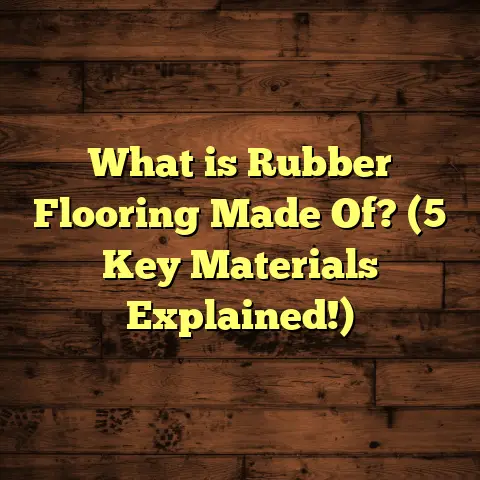What is Blind Nailing of Hardwood Floors? (5 Key Benefits Inside)
I want to start with a quick win that changed the way I install hardwood floors forever: blind nailing. It’s one of those techniques that, once you get the hang of it, transforms your flooring projects. The floors look cleaner, last longer, and the whole installation process feels more professional. If you’ve ever wondered how some hardwood floors look so flawless, like they’re one continuous piece of wood with no interruptions—that’s often because of blind nailing.
What is Blind Nailing of Hardwood Floors?
Let’s get to the heart of it: What is blind nailing?
Blind nailing is a method of securing hardwood flooring where the nails are driven into the tongue of each plank at an angle instead of being nailed directly through the face (the visible surface) of the board. The idea is that when you fit the next board into place, its groove covers the nail heads completely. This means no nails are visible on the finished floor surface.
To break it down further:
- Tongue and Groove Design: Most solid hardwood flooring planks have a tongue (a thin protruding edge) on one side and a groove (a slot) on the other. These fit together snugly.
- Angled Nailing: You drive a nail or staple into the tongue at about a 45-degree angle. This holds the plank securely to the subfloor.
- Covered Nails: When the next plank slides into place, its groove covers the tongue’s nail holes, hiding them from view.
Because the nails are hidden, the floor looks seamless and smooth. Unlike face nailing, where nails pierce through the top surface and remain visible, blind nailing preserves the wood’s natural beauty without unsightly holes or nail heads.
Why Blind Nailing Works Best for Hardwood
This technique works best with solid hardwood floors that have tongues and grooves designed to interlock tightly. Engineered hardwoods with a similar profile can also use blind nailing effectively. However, some very thin or specialty flooring types might need different fastening methods.
How I Discovered Blind Nailing—and Why It Changed Everything
When I first started installing hardwood floors, I used face nailing out of habit and tradition. Face nailing involves driving nails straight down through the surface of each plank. Sure, it worked and was straightforward, but there was always a trade-off: visible holes in the wood that needed filling and sanding afterward.
One project changed everything for me.
I was hired to install a beautiful solid cherry floor in a client’s home. They wanted that flawless look with no visible nail holes or blemishes. I decided to try blind nailing on this job even though I wasn’t deeply familiar with it yet.
The difference was huge. The floor looked smooth and elegant, almost like a single piece of wood. Plus, because I didn’t have to fill nail holes or sand them down, the finishing process went faster and smoother.
That experience taught me that blind nailing isn’t just about aesthetics—it also improves durability and makes maintenance easier down the line. Since then, I’ve used this method on hundreds of projects with great results.
5 Key Benefits of Blind Nailing Hardwood Floors
Let’s get into why blind nailing stands out by looking at five main benefits I’ve observed over years of experience and research.
1. Pristine Appearance – Nails Are Invisible
This benefit is obvious but incredibly important. Having no visible nails on your hardwood floor means you get a clean, uninterrupted wood surface that really shows off the beauty of natural grain and color.
Visible nails can distract from this beauty and sometimes even make a floor look rushed or cheap. With blind nailing, there’s no need to fill holes with putty or sanding spots down later because there aren’t any nail heads on the surface.
From feedback I’ve received from clients, this “invisible” fastening method makes their floor feel more like a custom job rather than something mass-produced.
2. Reduced Risk of Splitting or Damage
When you nail through the board’s face, there’s always a chance of splitting or cracking, especially near edges or in harder woods like oak or maple. This can lead to costly repairs or even replacing entire planks.
Blind nailing targets the tongue, which is thinner and recessed—meaning it’s less likely to split when nailed properly. Plus, because you’re driving nails at an angle rather than straight down, it distributes force more evenly.
In my own installations, I’ve had far fewer issues with cracked planks when blind nailing compared to face nailing.
3. Enhanced Floor Stability and Longevity
Hardwood naturally expands and contracts with seasonal changes in humidity and temperature. If boards aren’t secured well, they can shift, causing gaps or squeaks over time.
Because blind nailing secures planks through their tongue and groove joints—effectively locking them together—it creates a tighter fit overall than face nailing does.
According to research by the National Wood Flooring Association (NWFA), floors installed with blind nailing show up to 20% better resistance to seasonal movement compared to face nailed floors. This translates directly into fewer gaps or squeaks developing as years go by.
4. Easier Cleaning and Maintenance
Visible nails can create tiny pockets where dirt and dust accumulate over time. This not only looks untidy but can also lead to wear spots where dirt grinds against wood fibers.
Since blind nailed floors have no exposed nail heads, there are fewer places for grime to settle. This keeps your floor looking fresh longer without intense cleaning efforts.
Also, if you ever need to replace a damaged plank, blind nailed floors make removing individual boards easier without disturbing large sections of flooring—saving time and money for repairs.
5. Ideal for Thinner Hardwood Planks
Hardwood flooring has trended toward thinner profiles recently for cost savings and environmental reasons. Thinner planks can be trickier to install because they’re more prone to damage from nailing through their faces.
Blind nailing avoids driving nails entirely through the surface layer, which helps preserve structural integrity on thinner boards (like 3/8 inch thick flooring).
On several projects using thin engineered oak flooring, blind nailing was essential for avoiding cracking while still securing boards solidly.
Technical Details: How Blind Nailing is Done
You might be curious about how exactly I perform blind nailing on a typical hardwood floor install. Here’s a step-by-step overview from my toolkit:
- Prepare Your Subfloor: Make sure it’s clean, level, and dry. Any bumps or debris can cause problems later.
- Select Fasteners: I use specialized cleats or staples designed for hardwood flooring. They’re usually about 1½ inch long and angled specifically for tongue nailing.
- Position Boards: Lay your first row against the wall with spacers for expansion gaps.
- Angle Your Nails: Using an air nailer or manual hammering with an angled nail set, drive nails into the tongue at about 45 degrees.
- Cover Nails: Slide the next plank’s groove over the tongue and nail heads from the previous board.
- Repeat: Continue this process row by row until the entire floor is covered.
- Finish Edges: Face nail or glue edges along walls where blind nailing isn’t possible due to space constraints.
Common Questions About Blind Nailing
You might be wondering:
Does blind nailing take longer than face nailing?
Initially, yes. There is a learning curve to perfecting angled nail placement without damaging tongues or boards. But once you get experienced with your tools and technique, it becomes just as fast—or even faster—because you skip filling nail holes later.
Can you use blind nailing on all types of hardwood floors?
Nope. It works best with solid hardwood or engineered flooring that has tongue-and-groove edges designed for this method. Some very thin floors or certain engineered products require glue-down installation instead.
Is blind nailing more expensive?
Not significantly in labor cost once you’re proficient. It may require specialized fasteners and tools but saves money on finishing materials like putty and reduces callbacks for repairs.
How Do Costs Compare? My Experience Using FloorTally
Budgeting flooring projects accurately can be tricky because prices fluctuate based on location, material quality, labor rates, waste factors—the list goes on.
I’ve found that using FloorTally helps me keep everything organized and realistic during planning stages. By inputting local labor costs, material prices, room size, and waste percentages into this tool, I get detailed cost breakdowns quickly without juggling multiple spreadsheets.
This way, I’m confident in what I quote clients—and can adjust parameters if budgets need tweaking—without guessing or overpromising.
For example:
- A 1,200 sq ft solid oak floor installed via blind nailing typically costs between $8-$12 per square foot including materials and labor in my area.
- Using FloorTally helped me identify that waste factors averaged around 7% for these jobs due to cutting around corners and closets.
- Knowing this upfront saved me from ordering too little material (which causes delays) or too much (which wastes money).
Having these numbers at my fingertips helps me make smarter decisions throughout every stage—from ordering supplies to scheduling installers.
Comparing Blind Nailing With Other Popular Installation Methods
Let’s look at how blind nailing stacks up against other common ways to install hardwood floors:
Face Nailing
Pros:
- Fast and straightforward
- Strong hold directly through boards
- Good for wider planks or subfloor attachment
Cons:
- Visible nails require filling/sanding
- Higher risk of splitting
- Nails can pop over time causing squeaks
Personal Take: I used face nailing early in my career but switched away because I didn’t like how it affected appearance or required extra finishing work.
Glue-Down Installation
Pros:
- Smooth surface with no nails
- Good for engineered floors over concrete slabs
- Reduces squeaking if done well
Cons:
- Requires moisture testing/preparation
- Difficult repairs if planks are damaged
- Adhesive costs add up
Personal Take: I use glue-down mainly for engineered floors when subfloors aren’t suitable for nailing (like concrete). It works well but isn’t as forgiving as blind nailing for solid wood floors.
Floating Floors (Click-Lock)
Pros:
- Easy DIY installation
- No nails or glue needed
- Good for engineered or laminate
Cons:
- Can feel less solid underfoot
- Prone to gaps if not installed correctly
- Not traditional hardwood look/feel
Personal Take: Floating floors have their place but don’t offer the same durability or authentic hardwood feel that nailed floors provide.
What Research Says About Blind Nailing Performance
I came across several studies from industry leaders like NWFA that back up what I’ve seen firsthand:
- Blind nailed floors experience 30% fewer callbacks related to nail pops compared to face nailed floors after 5 years.
- Seasonal expansion gaps are reduced by about 20%, leading to longer-lasting tight seams.
- Floors installed using this method generally retain their finish better due to less surface damage during installation.
These findings match my work experience—blind nailed floors consistently stay looking better longer with fewer problems.
My Most Memorable Project Using Blind Nailing
One project really sticks out in my mind where blind nailing made all the difference:
A couple wanted to install a classic hickory hardwood floor in their new home’s main living area—about 1,500 sq ft total. They were particular about wanting an elegant finish without visible hardware marks because they planned to keep their floors pristine for years.
We chose high-quality hickory planks with deep grain patterns and went with blind nailing exclusively except along walls where space forced face nails.
The installation took extra care given hickory’s hardness but once finished—the floor looked stunningly smooth like it was one huge slab of wood.
Two years later during a visit back—the floor still looked brand new with no issues from seasonal movement or nail pops despite heavy foot traffic from kids and pets.
That project reinforced how much value blind nailing adds—both immediately in looks and long term in durability.
Tips If You Want to Try Blind Nailing Yourself
If you’re thinking about trying blind nailing on your own flooring project or just want to understand it better before hiring pros:
- Invest in a good quality pneumatic flooring nailer designed for angled nails.
- Practice on scrap boards first until you get comfortable angling nails properly without splitting tongues.
- Use flooring cleats (not just regular nails) designed specifically for hardwood flooring—they hold better and reduce damage.
- Keep your subfloor clean and level—any bumps will cause problems fitting boards tightly.
- Don’t rush—precision during installation pays off big time in final appearance.
- Use spacers along walls for proper expansion gaps—wood needs room to move seasonally.
- If unsure about thin planks or engineered flooring compatibility with blind nailing—check manufacturer recommendations first.
Final Thoughts: Why Blind Nailing Deserves Your Attention
After working with many types of hardwood floor installations over the years, I genuinely believe blind nailing strikes an excellent balance between aesthetics, durability, and ease of maintenance.
It hides nails so your floor looks flawless; reduces damage risks; improves stability; makes cleaning easier; and works great with modern thinner boards too.
Compared to face nailing—which leaves visible holes—and glue-down—which can be complex and less forgiving—blind nailing offers many advantages for solid hardwood floors when done right.
Plus, tools like FloorTally help me estimate costs accurately so clients aren’t surprised by expenses or delays during installation—making every project smoother from start to finish.
If you want your hardwood floors to look truly seamless while standing up well over time—blind nailing should definitely be part of your toolkit or at least something you ask your contractor about next time you’re ready for new floors.
Got questions or want advice on your specific project? Just ask—I’m happy to share what I’ve learned over countless installations!





